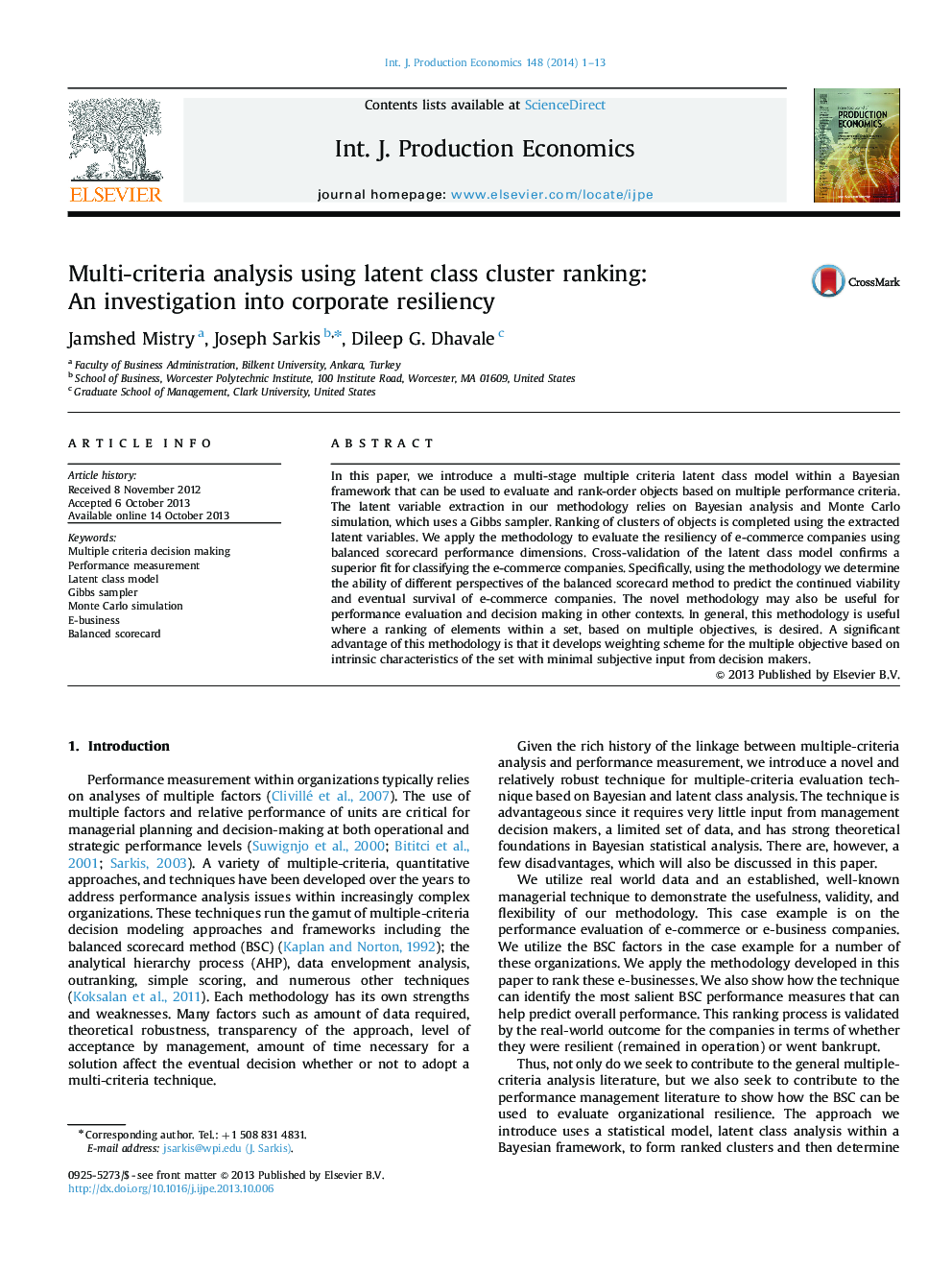| کد مقاله | کد نشریه | سال انتشار | مقاله انگلیسی | نسخه تمام متن |
|---|---|---|---|---|
| 5080191 | 1477564 | 2014 | 13 صفحه PDF | دانلود رایگان |
عنوان انگلیسی مقاله ISI
Multi-criteria analysis using latent class cluster ranking: An investigation into corporate resiliency
ترجمه فارسی عنوان
تجزیه و تحلیل چند معیاره با استفاده از رتبه بندی خوشه ای کلاس پنهان: تحقیق در مورد انعطاف پذیری شرکت ها
دانلود مقاله + سفارش ترجمه
دانلود مقاله ISI انگلیسی
رایگان برای ایرانیان
کلمات کلیدی
تصمیم گیری چند معیار، اندازه گیری عملکرد، مدل کلاس خاموش نمونه گیبس، شبیه سازی مونت کارلو، تجارت الکترونیک، کارت امتیازی متوازن،
ترجمه چکیده
در این مقاله، ما یک مدل کلاس نامتجانس چند مرحله ای چند مرحله ای در یک چارچوب بیزی را معرفی می کنیم که می تواند برای ارزیابی و ارزیابی اشیاء بر اساس معیارهای عملکرد چندگانه استفاده شود. استخراج متغیر پنهان در روش ما متکی به تحلیل بیزی و شبیه سازی مونت کارلو است که از نمونه گیر گیبس استفاده می کند. رتبه بندی خوشه های اشیاء با استفاده از متغیرهای پنهان استخراج شده تکمیل می شود. ما روش برای ارزیابی انعطاف پذیری شرکت های تجارت الکترونیک با استفاده از ابعاد عملکرد کارت امتیازی متوازن می پردازیم. اعتبارسنجی کلاسی از مدل کلاس پنهان، یک ویژگی برتر برای طبقه بندی شرکت های تجارت الکترونیک را تأیید می کند. به طور خاص، با استفاده از روش شناسی، توانایی دیدگاه های مختلف روش کارت امتیازی متوازن را برای پیش بینی زنده ماندن و بقای احتمالی شرکت های تجارت الکترونیک تعیین می کنیم. روش تحقیق نیز ممکن است برای ارزیابی عملکرد و تصمیم گیری در سایر زمینه ها مفید باشد. به طور کلی، این روش مفید است که در آن یک رتبه بندی از عناصر در یک مجموعه، بر اساس چندین هدف، مورد نظر است. مزیت قابل توجه این روش این است که طرح وزن گیری برای هدف چند گانه بر اساس ویژگی های درونی مجموعه با حداقل ورودی ذهنی از تصمیم گیران توسعه می یابد.
موضوعات مرتبط
مهندسی و علوم پایه
سایر رشته های مهندسی
مهندسی صنعتی و تولید
چکیده انگلیسی
In this paper, we introduce a multi-stage multiple criteria latent class model within a Bayesian framework that can be used to evaluate and rank-order objects based on multiple performance criteria. The latent variable extraction in our methodology relies on Bayesian analysis and Monte Carlo simulation, which uses a Gibbs sampler. Ranking of clusters of objects is completed using the extracted latent variables. We apply the methodology to evaluate the resiliency of e-commerce companies using balanced scorecard performance dimensions. Cross-validation of the latent class model confirms a superior fit for classifying the e-commerce companies. Specifically, using the methodology we determine the ability of different perspectives of the balanced scorecard method to predict the continued viability and eventual survival of e-commerce companies. The novel methodology may also be useful for performance evaluation and decision making in other contexts. In general, this methodology is useful where a ranking of elements within a set, based on multiple objectives, is desired. A significant advantage of this methodology is that it develops weighting scheme for the multiple objective based on intrinsic characteristics of the set with minimal subjective input from decision makers.
ناشر
Database: Elsevier - ScienceDirect (ساینس دایرکت)
Journal: International Journal of Production Economics - Volume 148, February 2014, Pages 1-13
Journal: International Journal of Production Economics - Volume 148, February 2014, Pages 1-13
نویسندگان
Jamshed Mistry, Joseph Sarkis, Dileep G. Dhavale,
